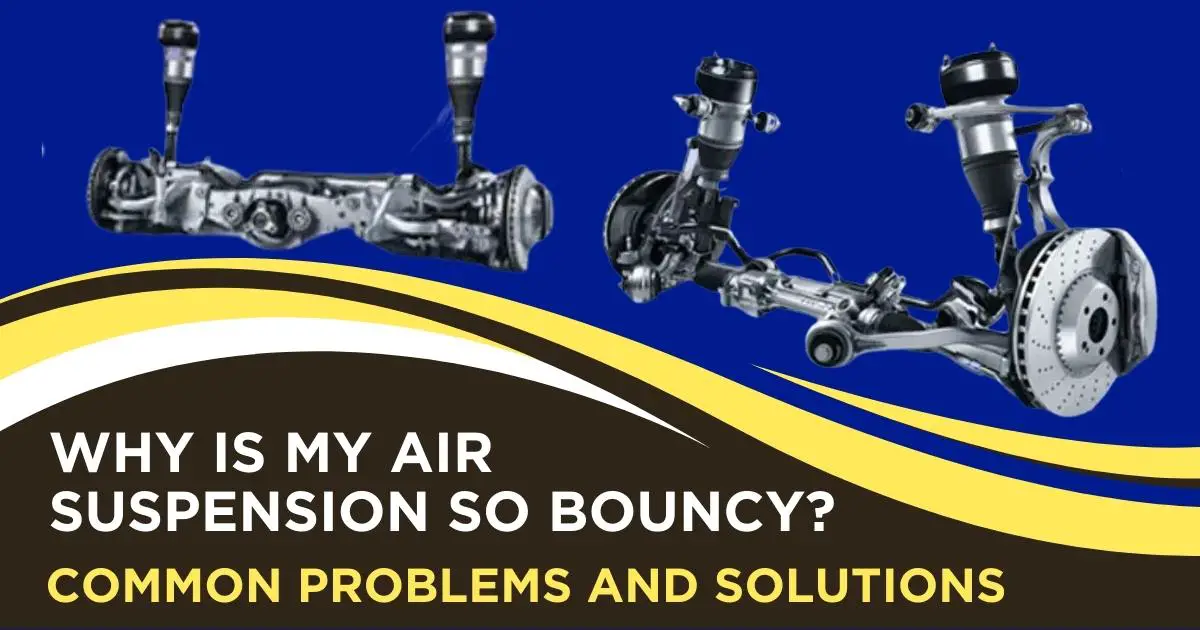Have you ever noticed how your car feels bouncy or saggy? That’s where the magic of the suspension system comes in. Traditionally, cars used springs and shocks to handle bumps and smooth things. But guess what? A cool thing called air suspension takes this game to a new level.
Air suspension systems provide a smoother and more comfortable ride, but like any mechanical system, they can develop issues over time. One of the most common and frustrating problems is a bouncy ride.
If you ever wonder, “Why is my air suspension so bouncy?” you’re not alone. Stick around to find out the answers to the following:
- Understanding air suspension,
- Common air ride suspension problems
- Identifying and fixing air suspension problems
- Maintenance tips to prevent bouncing.
Understanding Air Suspension System
Before we delve into common air suspension problems and their solutions, let’s first understand the air suspension system and why we use it in vehicles.
In regular cars, springs and shocks do the heavy lifting. Springs carry the car’s weight and decide how high it sits. Shocks help control the bounciness. But air suspension? It’s like having magical balloons that can adjust themselves.
These air-filled balloons, sometimes with regular springs, make your ride super comfy. Imagine your car sensing extra weight in the back, like when loading a truck. With air suspension, it goes, “Got it!” and automatically pumps up the balloons, bringing your car back to its usual height.
Air suspension replaces traditional coil or leaf spring suspension with air-filled bags or springs. Adjusting the air pressure in these air springs enables the system to adapt to various driving conditions and deliver a smoother ride.
Air suspension systems offer several advantages, including improved ride quality, adjusted ride height, and adaptability to varying loads and road conditions.

Common Air Ride Suspension Problems
Despite their advantages, air suspension systems can experience various issues, including bouncing. Here, we’ll examine the common problems related to air suspension systems.
Causes of Bouncing in Air Suspension
Worn-out Air Springs or Bags
Over time, the components of air springs, made of rubber or fabric, can wear down. This wear and tear results in pressure loss, causing your car to bounce excessively. The remedy for this issue often involves replacing the worn-out air springs to restore the proper support and damping.
Incorrect Air Pressure
Proper air pressure is crucial for a well-balanced suspension. Inadequate adjustments can lead to an imbalance, causing your vehicle to bounce more than it should. Regularly checking and adjusting the air pressure in your suspension system can help maintain the desired ride comfort.
Damaged Shock Absorbers
Shock absorbers are crucial in damping vibrations and controlling the suspension’s rebound. When these components wear out or get damaged, your car may start bouncing excessively. Replacing the damaged shock absorbers is often the solution to regain a smoother ride.
Faulty Height Sensors or Control Modules
Height sensors and control modules are responsible for adjusting the ride height of your air suspension. If these components malfunction, they can lead to an unstable suspension, causing your vehicle to bounce unpredictably. Diagnosing and replacing faulty sensors or modules can restore the proper functionality of your air suspension.
So, how do you find out the symptoms of a bouncy air suspension? This is relatively straightforward. Look out for:
- Excessive vertical movement when driving over bumps or uneven roads.
- Unpredictable handling and reduced stability, especially during turns.
- Harsh jolts or impacts when encountering potholes or rough surfaces.
- An overall uncomfortable and unsettling driving experience.
In addition to the symptoms mentioned above, other methods exist to identify air suspension issues, as explained below.
Identifying and Fixing Air Suspension Problems
As you drive, you must pay more attention to the initial indicators signaling potential air suspension problems. Regrettably, if you miss these signs, the issues worsen and become more costly. So, here are a few indicators of air suspension problems:
Dashboard Whispers – The Blinking Clue
First off, has your car been whispering through a blinking dashboard light? That little light is like your car’s secret language, and when it flickers, it’s saying, “Hey, something’s up with my air suspension.” Even if it plays peek-a-boo and disappears, it’s your cue to investigate.
Possible Fix: Time to consult the mechanic and their trusty scan tool. It’s like using high-tech glasses to decipher the hidden codes and figure out what your car’s been trying to tell you.
Sinking Feelings – Suspension Sagging
Now, imagine your car feeling a bit low, especially in corners. It’s like your vehicle’s saying, “I need a pick-me-up.” This sagging sensation usually happens when the rubber air springs get tiny cracks or holes. Your car’s like, “I’ve got leaks, folks!” Those leaks might be the culprits if they drop in height after a nap in the parking lot.
Possible Fix: Mechanics use their magic tools, like bidirectional control and soapy solutions, to locate those sneaky leaks. It’s like conducting a bubbly investigation to pinpoint where your car’s losing air.
The Compressor’s Dilemma
Now, is your compressor working overtime? If it constantly pumps air to keep things afloat, your car might feel like it’s doing aerobics. But here’s the catch: if that compressor is on a non-stop workout routine, it’s a sign of trouble. Overworked compressors overheat and, eventually, throw in the towel.
Possible Fix: Mechanics, armed with lab scopes and amp probes, become the fitness trainers for your compressor. It’s like monitoring your car’s heartbeat, ensuring it’s not overexerting, and recognizing a failing pump’s signature before it shows symptoms. That’s like preventive care for your car’s fitness.
When the Compressor Goes Mute
Conversely, what if the compressor takes a vow of silence? It’s like the conductor abandoning the orchestra if it doesn’t come on. Your air suspension can’t function without the compressor, and that’s a big deal.
The compressor pumps air into the suspension system to maintain the desired ride height. Compressor failures can lead to an imbalanced suspension, uneven ride height, and poor ride quality. Worn-out compressor components or electrical problems can cause these failures.
Possible Fix: It’s time to investigate why the maestro is taking a break. It could be a fuse, a relay issue, or something more complex. Think of it as your car asking for a tune-up for its silent companion.
When the Compressor is Making Noises
Imagine your car making creepy noises during the compressor’s operation – clicks, whines, or grinding sounds. It’s like your car auditioning for a Halloween special. It could indicate that the compressors had too much drama or excess moisture in the system.
Possible Fix: Once the compressor gets a makeover, the rest of the gang – air springs and struts – need their check-up. It’s like ensuring the whole spooky orchestra is ready for the next performance.
But the air suspension mystery doesn’t stop there. Your car might drop more clues, like:
- Bouncing after hitting a bump
- Pulling to one side or tricky steering
- Bottoming out over bumps
- Uneven tire wear
- Oily or damaged shocks
Diagnosing the Bouncing Problem
A bouncy air suspension is one of the common problems of the air suspension system. If you’ve been experiencing it, diagnosing the problem accurately before seeking a solution is essential. Here’s a systematic approach to identifying the root cause of the bouncing issue:
Steps to Identify the Root Cause of Air Suspension Bouncing
Visual Inspection: Start with a visual examination of the air suspension components. Look for visible damage, wear, or leaks in the air springs, lines, and fittings. These components may need replacement if you notice any noticeable issues, such as cracked air springs or damaged airlines.
Checking for Leaks: Air leaks commonly cause bouncy air suspension. While pressurizing the system, apply soapy water to the airlines and connections to detect leaks. If you observe bubbles forming at any point, it indicates an air leak that you need to address.
Diagnosing Sensor and Control Issues: If you find no visible issues or leaks, the problem may be related to the height sensors or control modules. Use a diagnostic tool or consult a technician to scan for error codes and determine whether these components function correctly. Calibrating or replacing these parts may be necessary.
Solutions to Bouncy Air Suspension
Once you’ve identified the root cause of the bouncing issue in your air suspension system, it’s time to explore the solutions to restore a smoother and more comfortable ride.
Repair Options
If worn-out air springs, air lines, or fittings are the culprits, replacing these components is a common and effective solution. High-quality replacement parts are essential to ensure the longevity and reliability of your air suspension system.
Addressing air leaks is crucial to maintaining air pressure in the system. After identifying the leak’s source, you can repair or replace the affected components. Regularly inspecting the system for potential leaks and addressing them can prevent future bouncing issues.
Air springs can cause wear out over time and lose their ability to maintain proper air pressure. When this happens, replacing them is often the best course of action. Ensure you choose air springs compatible with your vehicle’s make and model for optimal performance.
You need to address sensor and control problems. These components may need calibration or replacement if the bouncing issue is related to sensor misalignment or control module failures. Seek the expertise of a professional technician equipped with specialized tools and knowledge to diagnose and address these issues.
Maintenance Tips to Prevent Bouncing
Preventive maintenance is vital to keeping your air suspension system in good condition and avoiding bouncing issues. Consider the following maintenance tips:
- Regular Inspections: Schedule regular inspections of your air suspension system to catch potential issues early. It can aid in averting the escalation of minor issues into significant and expensive repairs.
- Maintaining the appropriate tire pressure is crucial for the optimal performance of your air suspension system. Check your vehicle’s manual for the recommended tire pressure and ensure you properly inflate your tires.
- Keeping the System Clean and Free from Debris: Dirt and debris can clog airlines and damage components, leading to air suspension problems. Regularly clean the air suspension components and ensure they are free from obstructions.
In some cases, upgrading to a more advanced or robust air suspension system may be worth considering. If you frequently encounter bouncing issues, even after repairs, upgrading to a better system with improved components and features can provide a more reliable and comfortable ride.
Important Read: How to Determine Brake Drum and Rotor Size Using VIN
When dealing with air suspension problems, it’s essential to consider the costs involved. Repairing and maintaining an air suspension system can be expensive, so weighing your options is crucial.
Estimating Repair Costs
The expense of fixing an air suspension system can fluctuate significantly, influenced by factors such as the severity of the damage, the vehicle type, and the quality of replacement parts. Obtaining quotes from multiple repair shops or technicians is advisable to ensure you get a fair and competitive price.
Weighing Repair Costs Against Replacement Costs
In some cases, the cost of repairing a problematic air suspension system may be high, and it might make financial sense to consider replacing the system altogether. When making this decision, consider the long-term benefits of a reliable air suspension system and the potential trade-in value of your vehicle.
Conclusion
A thorough diagnosis and appropriate actions are necessary to regain control over your vehicle’s bounce. Whether replacing worn-out components, adjusting air pressure, or addressing sensor issues, a proactive approach can transform your bouncy ride into your desired smooth journey.
In the world of automotive comfort, understanding the reasons behind your bouncy air suspension is the first step towards reclaiming that effortless and enjoyable driving experience. But, when in doubt, consult a professional air suspension technician for proper care, ensuring a smoother and more enjoyable ride.
